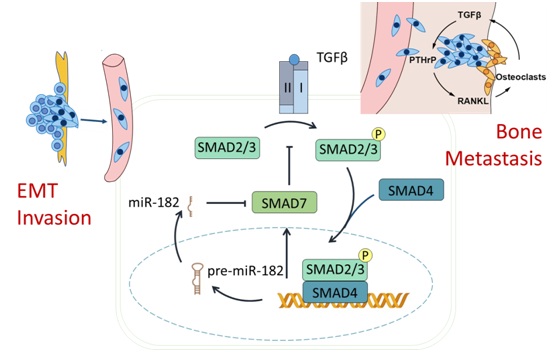
The TGFβ signaling plays vital roles in multiple biological processes. During cancer progression, TGFβ stimulation promotes cancer cell epithelial-mesenchymal transition (EMT) and invasiveness, as well as tumor microenvironmental remodeling. Particularly TGFβ responsiveness is critical for cancer cells to initiate osteolytic vicious cycle for bone metastasis. However, the regulation of this pathway in cancer cells has not been completely understood.
One of the loose ends is the regulation of SMAD7, the inhibitory SMAD protein of TGFβ pathway. As SMAD7 transcription is induced by TGFβ, it represents a negative feedback mechanism which can be regarded as a brake to restrain TGFβ signal in physiological conditions. But it is not known whether and how cancer cells can escape such restraint of TGFβ signaling during metastasis.
Researchers from the Institute of Health Sciences, Shanghai Institutes for Biological Sciences of Chinese Academy of Sciences and Shanghai Jiao Tong University School of Medicine found that in cancer cells the SMAD7-mediated TGFβ negative feedback loop is disrupted by microRNA-182 (miR-182), which potentiates TGFβ-induced EMT and metastasis microenvironment adaptation. The study entitled “MicroRNA-182 Targets SMAD7 to Potentiate TGFβ-Induced Epithelial-Mesenchymal Transition and Metastasis of Cancer Cells” was published in Nature Communications.
The researchers showed that miR-182 induction on TGFβ stimulation could abate TGFβ-induced SMAD7 expression, thus revealed the potentiating role of miR-182 in cancer cell responses to TGFβ. Moreover, they found that miR-182 is critical in TGFβ-driven EMT, invasion, as well as cancer cell-induced osteoclastogenesis, which suggested miR-182 as a new target to treat TGFβ-driven metastasis.
This study was supported by National Natural Science Foundation of China, the Ministry of Science and Technology of China, Chinese Academy of Sciences and Science and Technology Commission of Shanghai Municipality.

The proposed role of miR-182 in the TGFβ-SMAD7 circuit. (Image by Dr. HU Guohong’s group)

86-10-68597521 (day)
86-10-68597289 (night)

86-10-68511095 (day)
86-10-68512458 (night)

cas_en@cas.cn

52 Sanlihe Rd., Xicheng District,
Beijing, China (100864)

